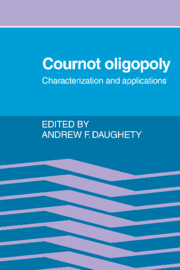Part IV - Applications
Published online by Cambridge University Press: 07 September 2009
Summary
Overview
This part rounds out the volume by presenting eight papers wherein the Cournot model plays a fundamental role in analyzing economic behavior. As indicated in the Introduction, there were literally hundreds of possible papers from which to choose. The organizing principle employed was to emphasize two aspects of this literature, applications of the Cournot model to provide insights about both the theoretical analyses of competitive behavior and the various observable outcomes of competitive behavior. The first five papers focus on three theoretical issues: obtaining Walrasian outcomes when firms have nonconvex technologies and some monopoly power; the incentives for competitors to implicitly correlate product market strategies via sharing of information when the ability to explicitly correlate via collusion is not possible; and the implications of strategic interaction for models that allow changes in the number of firms in an industry. The rest of the papers in this part use a Cournot model to understand seemingly contradictory behavior in the “real world.” Let us consider each topic area in turn.
Papers focusing on theoretical models of competitive behavior
It is probably universally true that the first model of competitive behavior a student encounters in a course in economics is that of perfect competition. Fundamental to the exposition is an assertion that firms take prices as given, or that even if they don't they somehow act as if they do.
- Type
- Chapter
- Information
- Cournot OligopolyCharacterization and Applications, pp. 263 - 268Publisher: Cambridge University PressPrint publication year: 1989



